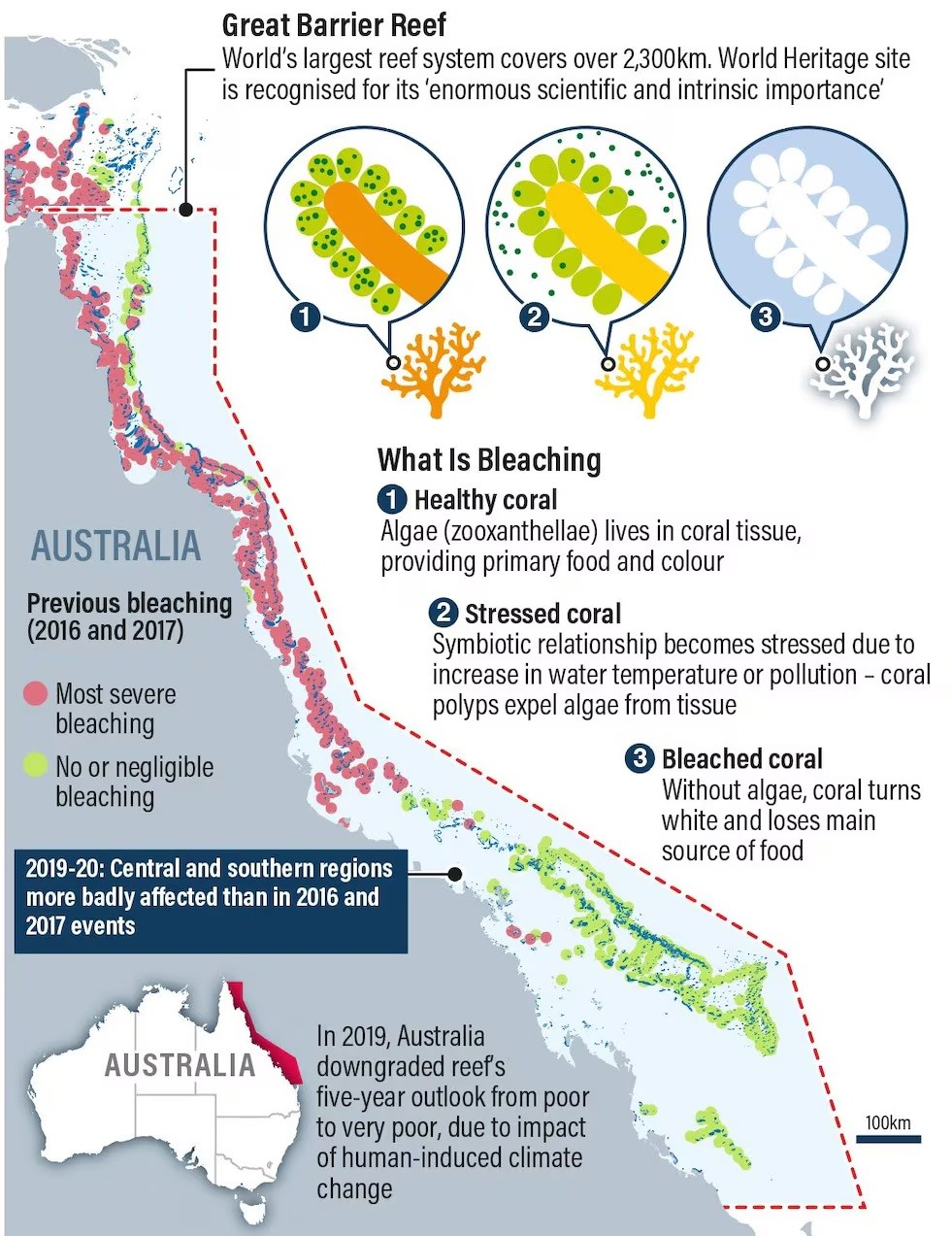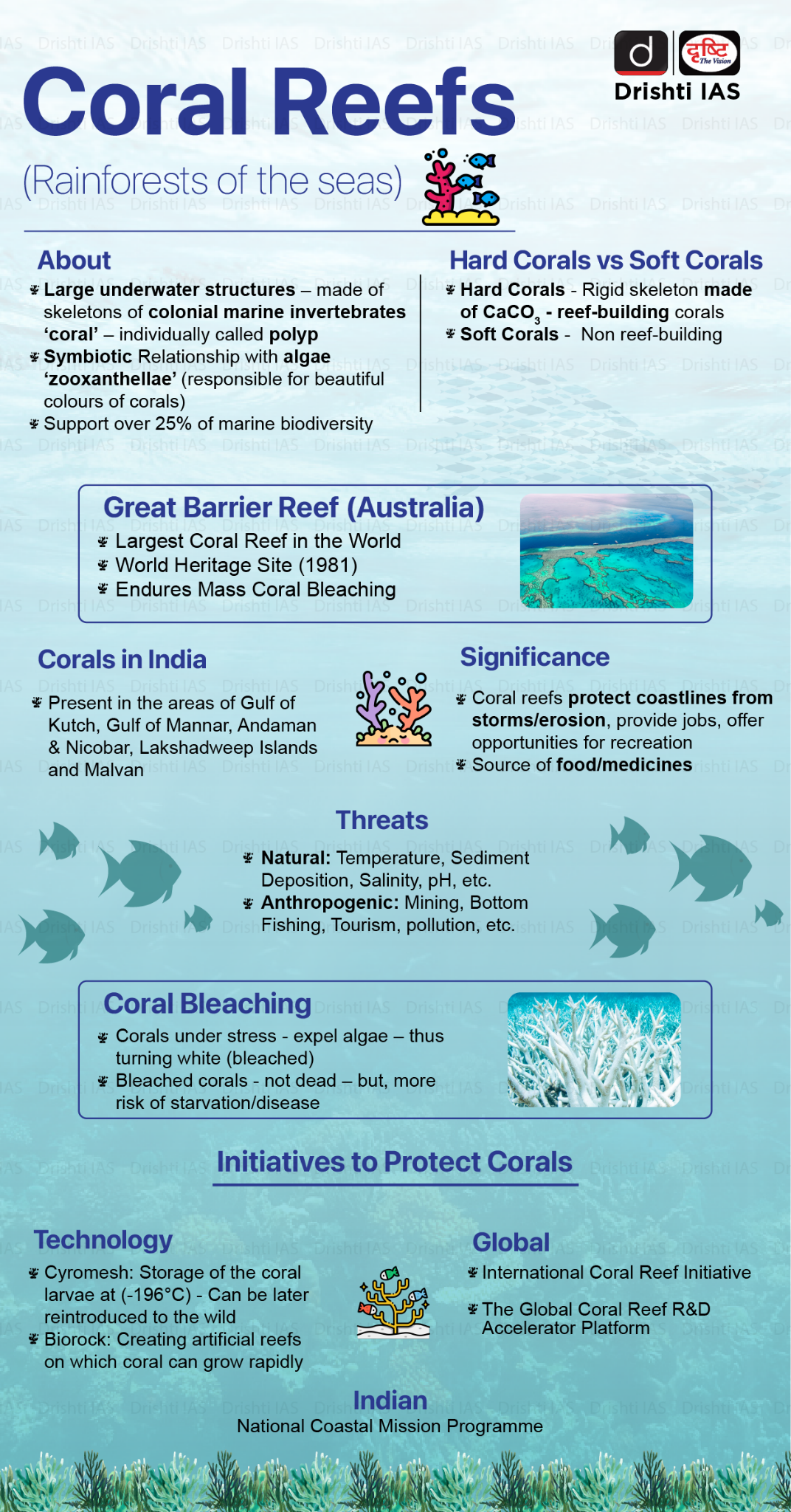Coral Bleaching in Great Barrier Reef | 13 Mar 2024
For Prelims: Coral Bleaching, Great Barrier Reef, El Nino, UNESCO World Heritage site
For Mains: Implications of coral bleaching on marine biodiversity, Climate Change
Why in News?
Recent aerial surveys conducted by Australian authorities confirm widespread coral bleaching across two-thirds of the Great Barrier Reef (GBR), signalling a dire threat exacerbated by climate change. Urgent action is needed to mitigate the impacts and protect this vital marine ecosystem.
Great Barrier Reef (GBR)
- The GBR is the world's largest coral reef system. It's located in the Coral Sea off the coast of Queensland, Australia.
- The GBR stretches across 2,300 km and is made up of around 3,000 individual reefs and 900 islands.
- The GBR is home to 400 types of coral, and 1,500 species of fish. It's also home to endangered species such as the dugong and the large green turtle. The GBR is a UNESCO World Heritage site and was inscribed in 1981.
- In 2023, the UNESCO Heritage Committee refrained from listing Australia’s Great Barrier Reef as a site "in danger" but warned that the world’s biggest coral reef ecosystem remained under "serious threat" from pollution and the warming of oceans.
- Widespread mass bleaching of the Great Barrier Reef was first seen in 1998 and happened again in 2002, 2016, 2017, 2020, 2022 and now in 2024.
What Factors are Contributing to the Coral Bleaching in GBR?
- Temperature Stress:
- Warmer water temperatures can trigger coral bleaching, causing corals to expel the algae (zooxanthellae) living in their tissues and turn white.
- Above-average sea surface temperatures over an extended period have led to significant heat stress on the reef, exacerbating the bleaching phenomenon.
- Bleached coral isn't dead, but weakened and susceptible to starvation and disease. Persistent stress can lead to coral death.
- Warmer water temperatures can trigger coral bleaching, causing corals to expel the algae (zooxanthellae) living in their tissues and turn white.
- Climate Change Impact:
- Rising ocean temperatures, exacerbated by climate change, increase coral susceptibility to stress and mortality, leading to widespread bleaching events globally due to El Niño conditions.
- Other Environmental Stressors:
- Cold water temperatures, pollution, runoff, and extreme low tides can also induce coral bleaching, highlighting the multifaceted nature of this phenomenon.
- Algae Relationship:
- Coral bleaching occurs when the symbiotic relationship between corals and algae is disrupted, impacting the corals' food source and making them vulnerable to disease.
What are the Implications of Coral Bleaching?
- Ecological Impact:
- Coral reefs (also called Rainforest of seas) are vital ecosystems that support a diverse range of marine life. Coral bleaching can lead to the loss of habitat and biodiversity, affecting fish populations, marine plants, and other organisms that depend on coral reefs for survival.
- Economic Consequences:
- Coral reefs are important for coastal protection, tourism, and fisheries. Coral reef ecosystems provide society with resources and services worth USD 375 billion per year. The degradation of coral reefs due to bleaching can have economic repercussions, impacting industries such as tourism and fishing, which rely on healthy reef ecosystems.
- Food Security:
- Coral reefs provide food and livelihoods for millions of people worldwide. Coral bleaching threatens the availability of seafood and can disrupt the livelihoods of communities dependent on fishing and reef-related tourism.
- Climate Change Indicator:
- Coral bleaching serves as a visible indicator of climate change impacts on marine ecosystems.
- Loss of Ecosystem Services:
- Coral reefs provide essential ecosystem services, including shoreline protection, nutrient cycling, and carbon sequestration.
- Bleaching diminishes the ability of reefs to provide these services, affecting the overall health of marine ecosystems and coastal communities.
UPSC Civil Services Examination, Previous Year Question (PYQ)
Prelims
Q. 1 "Biorock technology" is talked about in which one of the following situations?
(a) Restoration of damaged coral reefs
(b) Development of building materials using plant residue
(c) Identification of areas for exploration/extraction of shale gas
(d) Providing salt licks for wild animals in forests/protected areas
Ans: (a)
Q.2 Consider the following statements: (2018)
- Most of the world’s coral reefs are in tropical waters.
- More than one-third of the world’s coral reefs are located in the territories of Australia, Indonesia and Philippines.
- Coral reefs host far more number of animal phyla than those hosted by tropical rainforests.
Which of the statements given above is/are correct?
(a) 1 and 2 only
(b) 3 only
(c) 1 and 3 only
(d) 1, 2 and 3
Ans: (d)
Q.3 Which of the following have coral reefs? (2014)
- Andaman and Nicobar Islands
- Gulf of Kachchh
- Gulf of Mannar
- Sunderbans
Select the correct answer using the code given below:
(a) 1, 2 and 3 only
(b) 2 and 4 only
(c) 1 and 3 only
(d) 1, 2, 3 and 4
Ans: (a)
Mains
Q. Assess the impact of global warming on the coral life system with examples. (2019)


